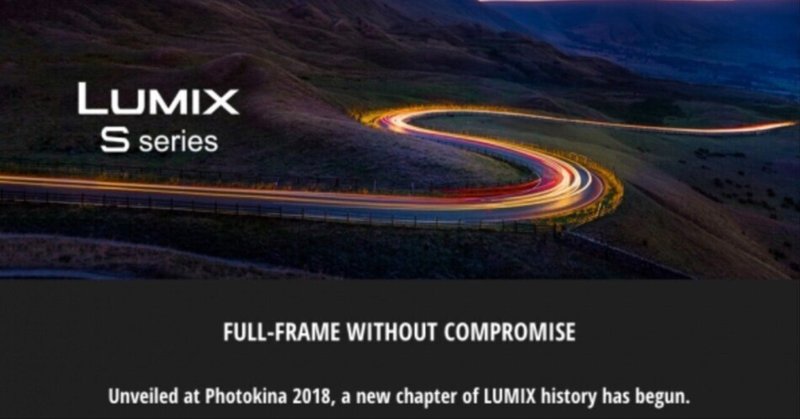
How Panasonic can fight the good fight in the full frame mirrorless camera market (2)
2019.01.15 06:00
The global website for Panasonic's LUMIX S series full-frame mirrorless cameras includes the phrase "FULL - FRAME WITHOUT COMPROMISE" (full frame without compromise) = photo =. This is clearly a challenge to Sony, which has no room in its mount diameter (46mm) because it was initially developed for the APS-C sensor, and to Nikon and Canon, which are still unmoved by the legacy of SLRs.
I mentioned in a previous article that the "LUMIX S series" uses the Leica L mount (51.6 mm mount diameter) developed by Leica. Since Leica already introduced the SL full-frame mirrorless camera to the market in 2015, the full-frame compatible lenses for this mount include five single focal length lenses (35mmF2, 50mmF1.4, 50mmmF2, 75mmF2, 90mmF2) and three zoom lenses (16-35mmF3. 5-4.5, 24-90mmF2.8-4, 90-280mmF2.8-4) are already on the market (all very expensive since they are Leica brand).
According to a Panasonic press release dated September 26, 2018, Panasonic itself declares that it will "develop a total of more than 10 interchangeable lenses by 2020" with the first three lenses (50mmF1.4, 24-105mm, and 70-200mm) on the market. This release shows that Panasonic is serious about full-frame mirrorless cameras. It is also expected that Sigma, a member of the "L-mount Alliance," will release lenses for this mount.
Now that we know that Panasonic is serious about entering the full-frame mirrorless camera market with its corporate fortunes on the line, we would like to consider actual tactics to secure market share.
First, as with Sony, the company could focus on appealing to affluent consumers in Asia, excluding Japan, where the influence of Nikon and Canon is likely to be relatively weak compared to other regions. Many of them have not been taking pictures with interchangeable lens cameras for decades.
They have plenty of money, so even if the selling price of the pixel-rich "LUMIX S1R" body is 500,000 yen, they are likely to buy it with two zoom lenses. Since there are many wealthy Asian tourists visiting Japan, if we can satisfy their demands, we should be able to sell a certain number of cameras.
Next, how do we get discerning users who are already using full-size mirrorless SLRs or full-size SLRs from the top three manufacturers to switch to the "LUMIX S series"? I don't think there is any particular formula, but if I had to venture a guess, I would say that it would be to have a photographer with great influence use the Lumix S series.
Mr. Seiya Nakai is a photographer who, like me, has always used Canon EOS as his main camera. It is unusual for a photographer to abandon Canon and switch to the Nikon D3, which has dramatically improved ultra-high-sensitivity shooting performance. The Nikon D3 is a full-frame SLR camera released in 2007.
Although full-frame SLR cameras had existed before that (e.g., the Canon EOS-1Ds released in 2002 and the Canon EOS5D released in 2005), their image data processing speed was slow and high-speed continuous shooting was impossible. The Nikon D3, which not only had ultra-high sensitivity shooting performance but also achieved high-speed continuous shooting at 9 fps, was a very revolutionary camera at the time, and I, who had always been a Canon user, envied Nikon users.
In 2012, Canon, which had been lagging behind Nikon, launched the EOS-1DX, a fully remodeled full-frame SLR camera, and regained its position as the flagship Nikon D4, two generations after the Nikon D3.
Seiya Nakai is currently a member of NHK BS Premium's "Seiya Nakai's Tetsudabi! and NTV's "Hirunandesu! and Nippon Television's "Hirunandesu!", his photographs are taken with a Sony full-frame mirrorless camera. TV's main audience is the elderly, and Japanese financial assets are unevenly distributed among the elderly. The effect of Sony's advertisement featuring Seiya Nakai should be substantial.
Giving away a camera and a set of lenses for free to a photographer with a lot of media exposure would likely produce excellent advertising results in terms of cost-effectiveness.
Let's say that Panasonic gave me a Lumix S1R, a Lumix S1, a 24-105mm lens, a 70-200mm lens, a wide-angle zoom lens (to be added), a 500mm f/4 telephoto lens, and 1.4x and 2x teleconverters. I, who have been a Canon user for more than 30 years, would most likely switch to Panasonic as my main camera if the camera body and lenses mentioned above were provided. I would then publish my works shot with Panasonic's full frame mirrorless camera in various media.
first appearance : AGORA
この記事が気に入ったらサポートをしてみませんか?
